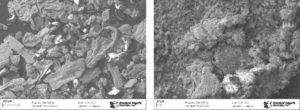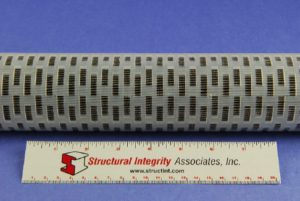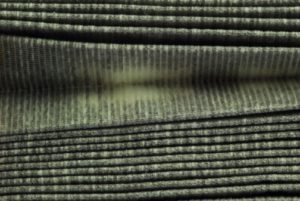Process Upsets – Condition Analysis
MATERIALS LABORATORY CASE STUDY 5
THE PROBLEM
A filter was removed from a stator cooling system after pressure differential sensors indicated it may be blocked. The filter was submitted to SI’s Materials Laboratory for analysis to help identify the material blocking it.
|
|
|
|
THE SOLUTION
The filter was visually examined and documented in the as-received condition as shown in Figure 1. The submitted sample had a perforated plastic shell that covered an inner filter. The outer plastic was removed to provide access to the filter underneath. Figure 2 shows close images of the filter, which was yellowish-white with much of its surface covered in gray colored debris/deposit.

Figure 3. SEM images of material removed directly from the filter (left) and particles from the evaporated MEK (right) B
A portion of the filter was scraped to remove the deposits. Another portion of the filter was removed and soaked in Methyl Ethyl Ketone (MEK) to remove the debris present on the filter. The solvent evaporated and the remaining particles were collected. Both samples were analyzed in a scanning electron microscope using energy dispersive X-ray Spectroscopy (EDS) to identify the elements present. The results are provided in Table 1. The results indicate that the filter debris was primarily copper oxide. Plant personnel reported that copper contamination could be occurring in the system, so these findings appeared to be consistent with plant information. With their suspicions confirmed, plant personnel were able to move forward with mitigation steps for keeping the filters from becoming blocked.
| Element | Material Removed from Filer | Particles from MEK Wash |
| Carbon | 4.9 | ND |
| Oxygen | 13.4 | 18.5 |
| Aluminum | 0.2 | 1.3 |
| Silicon | 0.4 | 4.2 |
| Sulfur | 0.1 | 0.3 |
| Chlorine | 0.1 | 0.1 |
| Chromium | 0.3 | 1.6 |
| Iron | 0.4 | 4.0 |
| Nickel | ND | 0.4 |
| Copper | 79.7 | 68.4 |
| Tin | 0.4 | 1.3 |
Table 1. Filter Material EDS Analysis Results (wt.%)
RELATED MATERIALS














